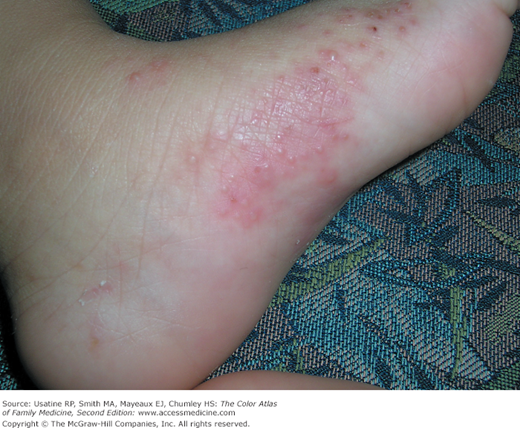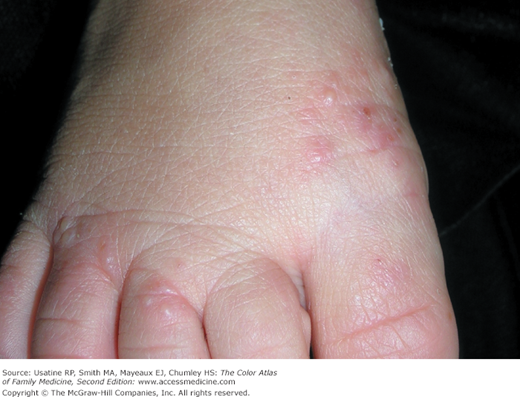Patient Story
A 1-year-old boy is brought for a second opinion about the recurrent pruritic vesicles and pustules on his hands and feet. This is the third episode, and in both previous episodes, the physicians thought the child had scabies. The child was treated with permethrin both times and within 2 to 3 weeks the skin cleared. No other family members have had lesions or symptoms. Figures 110-1, 110-2, 110-3 demonstrate a typical case of infantile acropustulosis that is often misdiagnosed as scabies. Although the condition can be recurrent, it is ultimately self-limited and will resolve.
Figure 110-2
Acropustulosis with vesiculopustular eruption on the toes of the boy shown in Figure 110-1. (Courtesy of Richard P. Usatine, MD.)
Figure 110-3
Acropustulosis with pruritic eruption on the hand and wrist of the boy shown in Figures 110-1 and 110-2. (Courtesy of Richard P. Usatine, MD.)
Introduction
Acropustulosis and transient neonatal pustular melanosis (TNPM) are pustular diseases that typically present in infancy. Acropustulosis is a pruritic vesiculopustular disease presenting between 2 and 10 months of age and remitting spontaneously by 36 months of age. TNPM is present at birth and characterized by 2- to 3-mm hyperpigmented macules and pustules. Acropustulosis may require symptomatic treatment of pruritus, but otherwise both illnesses are self-limiting.
Epidemiology
Etiology and Pathophysiology
- The exact cause and mechanism have yet to be determined.5
- Some physicians speculate that it is a persistent reaction to scabies (“postscabies syndrome”). Suggestive of this infectious etiology, infantile acropustulosis will occasionally be concurrently present amongst siblings. Also, patients diagnosed with this disorder frequently have received prior treatment for scabies, which may either provide evidence of an infectious etiology or demonstrate the frequent misdiagnosis, as in the patient above. Odom et al. concludes that in some cases, this disease may represent a hypersensitivity reaction to Sarcoptes scabiei.4
Stay updated, free articles. Join our Telegram channel

Full access? Get Clinical Tree





